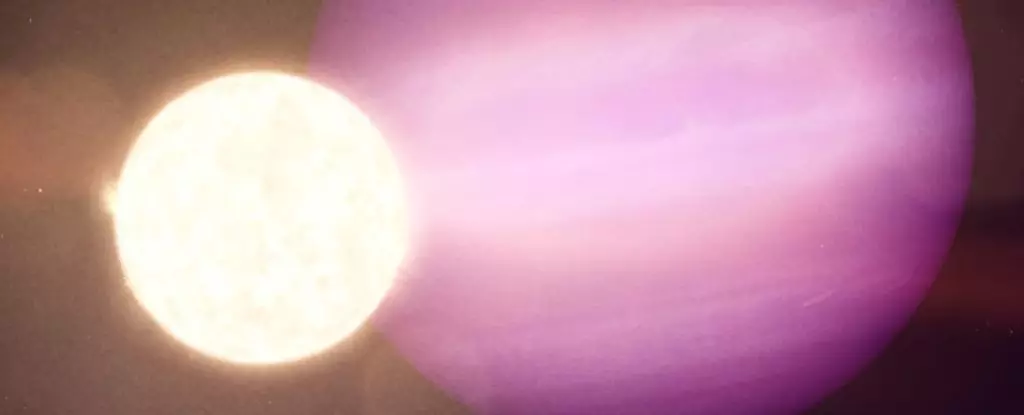In a remarkable scientific achievement, astronomers have made monumental strides in exoplanet research by uncovering WD 1856+534 b, a gas giant that orbits a white dwarf star situated 81 light-years from Earth. This transmission exoplanet, roughly six times more massive than Jupiter and categorized as a “super-Jupiter,” has sparked immense interest within the astronomical community. The discovery holds a distinct significance as WD 1856+534 b was the first of its kind to be found orbiting a white dwarf, providing a unique window into a class of celestial bodies that challenge previous notions of planetary formation and survival.
The efforts to investigate this enigmatic exoplanet were led by Mary Anne Limbach, an Assistant Research Scientist at the University of Michigan, in collaboration with an impressive roster of institutions including MIT, Johns Hopkins University, and the University of Victoria. Their endeavors were realized through the advanced capabilities of the James Webb Space Telescope (JWST), notably utilizing its Mid-Infrared Instrument (MIRI) for direct observations. These observations confirmed that WD 1856+534 b stands as the coldest exoplanet thus far documented, with an impressive average atmospheric temperature of just 186 K (-87 °C; -125 °F).
The Power of Advanced Technology
At the heart of this discovery is the JWST, a technologically advanced telescope designed to push the boundaries of our understanding of the universe. It is equipped with sophisticated infrared optics and spectrometers, enabling astronomers to conduct detailed characterizations of distant worlds. Through its Direct Imaging Method, JWST can capture the light reflected from an exoplanet’s surface or atmosphere, analyzing it for chemical signatures that may suggest the potential for life. This method represents an innovative leap in the field of astronomy, aiming to pave the way for future findings that could provide compelling evidence of life beyond our solar system.
Detecting light from an exoplanet presents immense challenges due to the overwhelming brightness of their respective stars, particularly in the case of planets orbiting main-sequence stars. This limitation is less pronounced in the context of white dwarfs. Their relatively low luminosity reduces the contrast issues that commonly obstruct direct observations of planets. Understanding WD stars and their planetary systems offers promising insights into how planets interact with their environment in the aftermath of a star’s lifecycle and whether these celestial bodies can maintain viable conditions conducive to life.
Significance of Cold Gas Giants
The discovery of WD 1856+534 b is especially significant in the realm of planetary classification. Not only does it provide a unique opportunity to analyze a cold gas giant, but it also challenges the existing paradigms about the survival of planets in close orbits around white dwarfs. Previous observations had not revealed any exoplanets with similar atmospheric emissions at temperatures cooler than 275 K, placing WD 1856+534 b in a league of its own.
Limbach’s team has been able to refine the mass estimates of this exoplanet down to no more than six Jupiter masses, a significant revision from prior estimates that suggested a heftier 13.8 Jupiter masses. This indicates a pressing need to reassess the characteristics of exoplanets that exist in such unusual environments. The study not only highlights the potential for continued exploration of these frigid worlds but also poses more extensive questions regarding their formation and migration processes across cosmic timelines.
Looking Ahead: The Future of Exoplanet Research
As scientists eagerly anticipate further observations of WD 1856+534 b, scheduled for 2025, the implications of this discovery stretch far beyond the cold gas giant itself. The outcomes of these endeavors will hopefully illuminate the potential for additional planets within this system and answer critical questions about the dynamics that could have nudged WD 1856+534 b into its current orbital path.
Moreover, the foreseeable release of results from the JWST’s Near-Infrared Spectrometer (NIRSpec) will likely provide initial insights into the composition of the planet’s atmosphere—an essential step in the ongoing quest to understand whether habitable conditions might exist even in the aftermath of stellar demise.
The discovery of WD 1856+534 b signals a renaissance in our understanding of planetary systems around white dwarfs, unlocking new avenues for research that could reshape our comprehension of planetary evolution. The significance of these findings not only lies in the direct data acquired but also in the profound questions they pose regarding life in the cosmos, ultimately driving humanity’s insatiable curiosity about our place in the universe.

